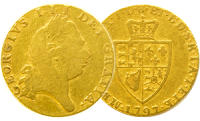... continued from the previous post
By Queen Mary's reign (1553-4), gold coins were once more struck to the 23¾ carat standard. The newly issued 'Fine Sovereigns' struck to this standard, were valued at 30 shillings.
 |
| Gold Crown Tower Mint, London, Hammer struck Queen Elizabeth I (1558-1603) |
In 1592, under the reign of Elizabeth I, a 22 carat (91.6%) gold 'Pound'
coin with a value of 20 shillings was introduced alongside the 30
shilling 'Fine Sovereign'. By 1603-4 in the reign of James I, this
confusing state of affairs had been rationalised (in the short-term) by
the issue of a smaller and lighter 22 carat gold sovereign coin valued,
once more, at 20 shillings. This was to be the last sovereign issued for
over two centuries!
The Unite, the Laurel and the Broad
In 1604, the weight of the gold sovereign/pound was again reduced and the new coin became known as the 'Unite'. In 1612, the 'unite' was revalued to 22 shillings. A yet again smaller 20 shilling gold coin - the 'Laurel' was introduced in 1619 but survived only until 1625 when the 'unite' was devalued to it's original value of 20 shillings.The 'unite' survived the civil war and execution of Charles I in 1649 and continued to be minted during Oliver Cromwell's 'Commonwealth'. Another, smaller 20 shilling gold coin known as the 'broad' was issued in 1656. After the 'Restoration' of Charles II to the crown in 1660, unites were hammered for another two years.
Gold from Guinea
In 1662, two major initiatives were introduced. Firstly, hand hammering
of coins was abandoned in favour of manufacture by the Roettiers
improved mill and screw presses. Secondly, new 20 shilling coins were
minted with gold imported by the Africa Company from Guinea - hence the
name of the new coin - the 'guinea'. 50 shilling (5 guinea) and 10
shilling (Half Guinea) coins were also introduced. All coins were minted
at the 22 carat (91.6%) gold standard.
 |
| 1691 William and Mary Guinea |
During the first of the Hanoverian kings, George I's, reign (1714-27) more changes occurred to the royal arms. The guinea was re-valued for the final time to 21 shillings in 1717 and remained at this value for 96 years. A short-lived issue of quarter-guinea coins was made in 1718 and in 1733, all hammered gold coins were officially withdrawn and demonetized.
 |
| 1797 "spade" Guinea coin |
continued in the next post...
Article source: australianstamp.com
No comments:
Post a Comment